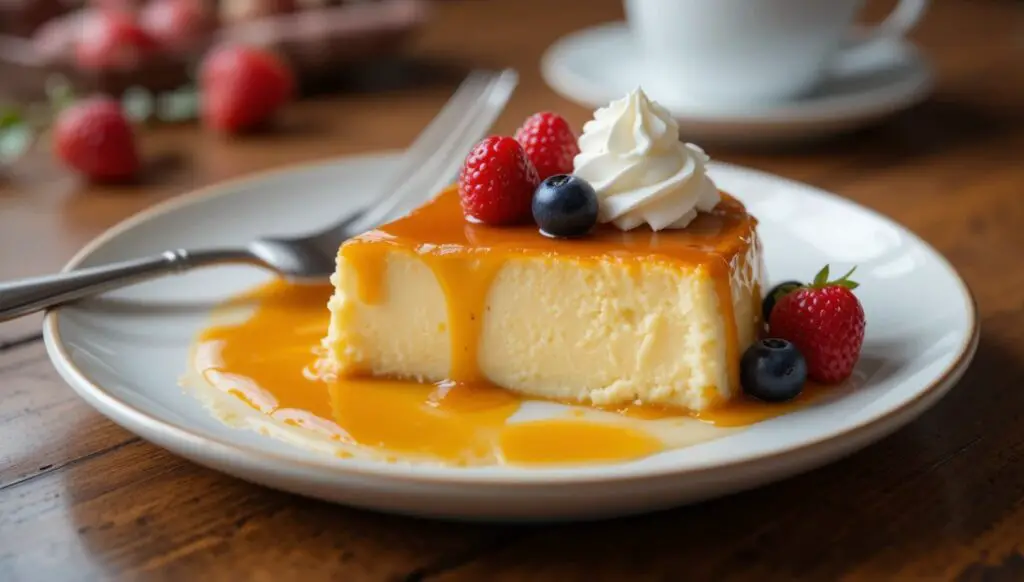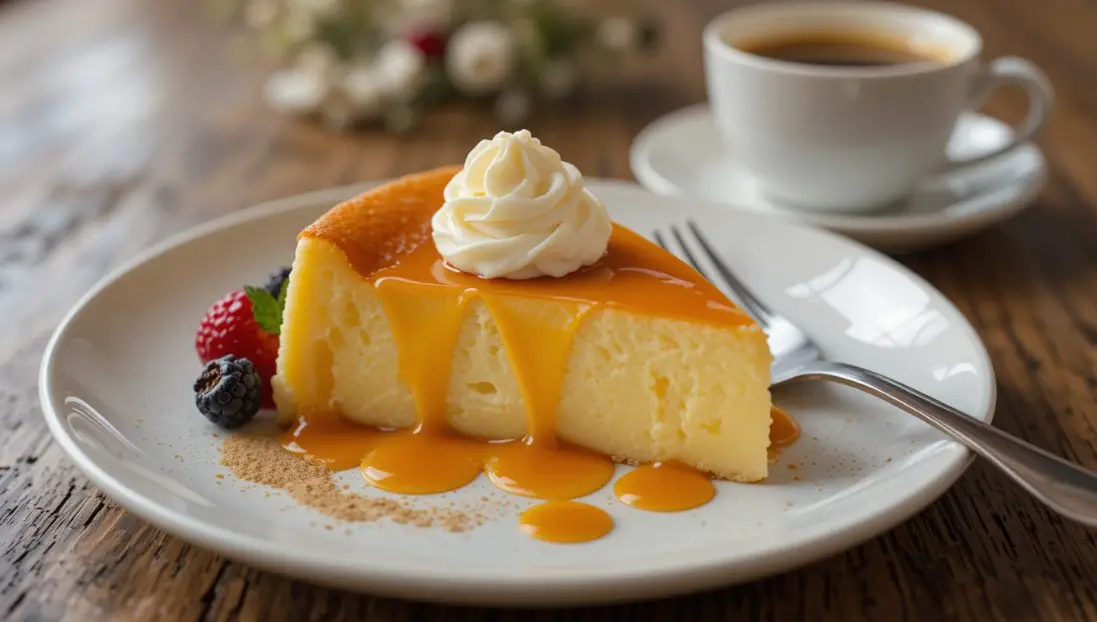Quesillo is a beloved Venezuelan dessert that resembles flan but has a distinct texture and flavor. This caramel-covered custard is known for its creamy yet slightly porous consistency, making it a favorite at family gatherings and celebrations. The name “quesillo” comes from the Spanish word for cheese, though it contains no cheese—its appearance and texture simply resemble that of a soft cheese. A well-made quesillo is rich, smooth, and has the perfect balance of sweetness and caramelized depth. Whether enjoyed on its own or with a side of fresh fruit, quesillo is a dessert that never disappoints.
The History and Cultural Significance of Quesillo
Quesillo has deep roots in Venezuelan culinary tradition, with its origins tracing back to Spanish influences. It evolved from European custards and flans brought to South America during colonial times. Over the years, it became a staple in Venezuelan households, particularly during birthdays, holidays, and festive occasions. Families often pass down their unique quesillo recipes through generations, making slight modifications to achieve the perfect texture and sweetness. Today, quesillo is enjoyed across Latin America, with slight regional variations, but its heart remains in Venezuelan cuisine.
Quesillo vs. Flan: Understanding the Differences
Although quesillo and flan are similar, they have key differences that set them apart. Flan typically has a dense, smooth texture, while quesillo has a lighter, slightly porous consistency due to the use of whole eggs rather than just yolks. Another distinction is the caramelization process—quesillo’s caramel layer tends to be richer and deeper in flavor. While flan recipes may include additional ingredients like cream or cornstarch, quesillo remains simple, relying on milk, eggs, and condensed milk to create its signature taste and texture.
Step-by-Step Guide to Making Authentic Quesillo
Making quesillo at home is simple if you follow each step carefully. The process involves caramelizing sugar, preparing the custard mixture, baking in a water bath, and allowing the dessert to set properly. Follow this step-by-step guide to achieve a perfect quesillo every time.
Ingredients:
- 1 cup white sugar (for caramel)
- 1 (14-ounce) can sweetened condensed milk
- 1 ¾ cups milk (or as needed)
- 3 large eggs
- 1 teaspoon vanilla extract
Instructions:
Step 1: Prepare the Caramel Layer
- In a medium-sized nonstick pan, heat 1 cup of white sugar over medium-low heat.
- Stir continuously until the sugar melts and turns into a golden-brown caramel (this takes about 7-10 minutes).
- Carefully pour the caramel into a flan mold, tilting it to coat the bottom and sides evenly.
- Set aside to cool slightly while you prepare the custard.
Step 2: Make the Custard Mixture
- In a mixing bowl, pour one can of sweetened condensed milk.
- Fill the empty condensed milk can with regular milk and add it to the bowl.
- Crack three large eggs into the mixture and add one teaspoon of vanilla extract.
- Whisk everything together until smooth and well combined.
- Lightly tap the bowl on the counter to remove air bubbles.
Step 3: Assemble and Bake
- Preheat the oven to 350°F (175°C).
- Pour the custard mixture into the caramel-coated flan mold.
- Cover the mold with its lid or aluminum foil.
- Place the mold inside a larger baking dish and fill the dish with hot water until it reaches halfway up the sides of the mold. This bain-marie (water bath) method ensures even cooking.
- Bake for 45 minutes. Then, remove the foil and bake for an additional 15 minutes until set.
Step 4: Cooling and Unmolding
- Remove the quesillo from the oven and let it cool at room temperature for about 25 minutes.
- Refrigerate for at least 8 hours or overnight to allow the flavors to develop.
- To unmold, run a knife along the edges of the mold, place a plate over it, and carefully flip it upside down.
- The caramel sauce will flow over the quesillo, creating a glossy finish.

Key Ingredients for the Perfect Venezuelan Quesillo
Each ingredient in quesillo plays a crucial role in achieving the perfect texture and flavor:
- Sugar: Forms the caramel base, giving quesillo its signature sweetness and depth.
- Condensed Milk: Adds richness and creaminess while enhancing sweetness.
- Regular Milk: Balances the condensed milk’s thickness, ensuring a smooth consistency.
- Eggs: The key to the custard’s texture, creating structure and that signature porous consistency.
- Vanilla Extract: Adds a warm, aromatic note that complements the caramelized sugar.
Tips and Tricks for a Smooth and Creamy Quesillo
Making quesillo requires precision, but these tips can help ensure perfect results:
- Use a Nonstick Pan for Caramel: This prevents sugar from burning and sticking to the pot.
- Whisk the Custard Gently: Over-whisking can create too many air bubbles, leading to a rough texture.
- Don’t Skip the Water Bath: The steam from the hot water keeps the custard smooth and prevents cracks.
- Let It Chill Overnight: This allows the flavors to meld and gives the quesillo a firmer texture for easy slicing.
- Invert Carefully: Warm the mold slightly by placing it in warm water for a few seconds before flipping to help release the caramel.
Common Mistakes to Avoid When Making Quesillo
Even experienced cooks can make mistakes when preparing quesillo. Here are some common pitfalls and how to avoid them:
- Burning the Caramel: If the sugar turns too dark, it will taste bitter. Remove from heat as soon as it reaches a golden amber color.
- Skipping the Water Bath: Without it, the custard may overcook, resulting in a rubbery texture.
- Unmolding Too Soon: Quesillo needs time to set properly. Refrigerate for at least 8 hours before inverting.
- Using Too Many Eggs: More eggs make the texture dense rather than light and porous.
Serving and Pairing Ideas: How to Enjoy Quesillo
Quesillo is delicious on its own, but it can also be paired with other flavors to enhance the experience:
- Fresh Berries: The tartness of raspberries or strawberries balances the sweet caramel.
- Whipped Cream: Adds a light and airy contrast to the dense custard.
- Coffee or Espresso: The bitterness of coffee complements the rich sweetness of quesillo.
- Dulce de Leche Drizzle: For an extra indulgent treat, add a drizzle of caramelized condensed milk.
- Tropical Fruits: Mangoes or passion fruit bring a refreshing twist to the dessert.
Final Thoughts
Quesillo is more than just a dessert—it’s a piece of Venezuelan heritage passed down through generations. Whether you’re making it for the first time or perfecting a family recipe, following these steps and tips will ensure a smooth, flavorful quesillo every time. So, the next time you crave something sweet and creamy, try making homemade quesillo and experience a true taste of Venezuela!



